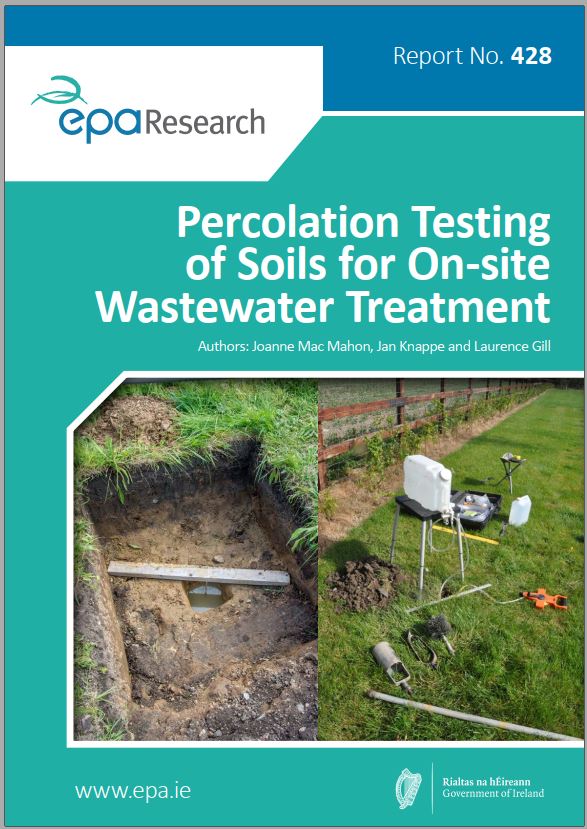Research 428: Percolation Testing of Soils for On-site Wastewater Treatment
Authors: Joanne Mac Mahon, Jan Knappe and Laurence Gill
Summary: Estimation of soil permeability is a critical aspect of on-site wastewater treatment system design. The findings of this research identify a need to revise the currently available options in the Irish Code of Practice for estimating soil permeability for on-site wastewater system design. In this research, a correlation was developed between field saturated hydraulic conductivity (Kfs) and percolation time (T-values) across a full range of Irish soil texture data.

Identifying Pressures
Estimation of soil permeability is a critical aspect of on-site wastewater treatment system design. In Ireland, domestic wastewater of approximately one-third of the population (approximately 500,000 dwellings) is treated by on-site domestic wastewater treatment systems (DWWTSs), of which around 90% are septic tanks. Site assessment (and subsequent DWWTS design) is prescribed in the Irish Code of Practice (CoP) and requires an on-site falling head percolation test, known nationally as the T-test. The test, however, is not practical for very low permeability soils due to the time required to obtain a valid result. It also produces results in units that are not directly comparable with current processes/standards in Ireland or other jurisdictions. This research, therefore, comprised carrying out a comprehensive literature review on soil permeability testing and international design standards as well as soliciting opinions from stakeholders and experts in the field of on-site wastewater treatment. It has also used the results of over 900 falling head percolation tests carried out across Ireland to produce equivalent soil permeability values using a numerical modelling approach with Hydrus 2D software, as well as testing an alternative constant head permeameter test.
Informing Policy
The findings of this research identify a need to revise the currently available options in the Irish CoP for estimating soil permeability for on-site wastewater system design. This conclusion is based on the current difficulties of conducting falling head percolation tests in less permeable soils, as well as the need to incorporate progress made in soil science theory and permeability estimation internationally in recent decades. A key conclusion from the research is that the constant head well permeameter test is considered a better alternative for in-situ percolation testing because it produces a more rigorous and transferable measure of soil permeability (saturated hydraulic conductivity), which is independent of the dimensions of the hole used in the test and is also the international standard measurement for water transmission through soil. However, many design standards in other international jurisdictions now indicate that in-situ permeability tests should be used only as a complement to detailed site assessments, particularly soil morphology analysis, in terms of texture, structure and consistency. Hence, we recommend that more emphasis be placed on the importance of the soil texture and structure classification aspect of the current site assessment methodology in the CoP.
Developing Solutions
In this research, a correlation was developed between field saturated hydraulic conductivity (Kfs) and percolation time (T-values) across a full range of Irish soil texture data. The model trendline was also found to fit with parallel falling head and constant head permeameter test results to a large degree, showing that the constant head permeameter test could be phased in initially as an additional option to the falling head test for on-site assessment in Ireland, particularly for low permeability soils. The research also emphasises that a critical element of site assessment is soil categorisation, which has become the primary recommended method for determining suitable hydraulic loading rates for soil treatment units in many regions. It is recommended that further research be carried out into this area of site assessment and an assessment made of the possibility of switching to an alternative soil categorisation system that provides a more finely tuned and flexible categorisation of soil permeability. Finally, a database of Kfs ranges for Irish soil types, in conjunction with mapping of this information, would be a useful tool for site assessors and local authority personnel in carrying out the overall assessment of sites.
https://www.epa.ie/media/epa-2020/research/epa-funded-research/Report-cover-428.jpg